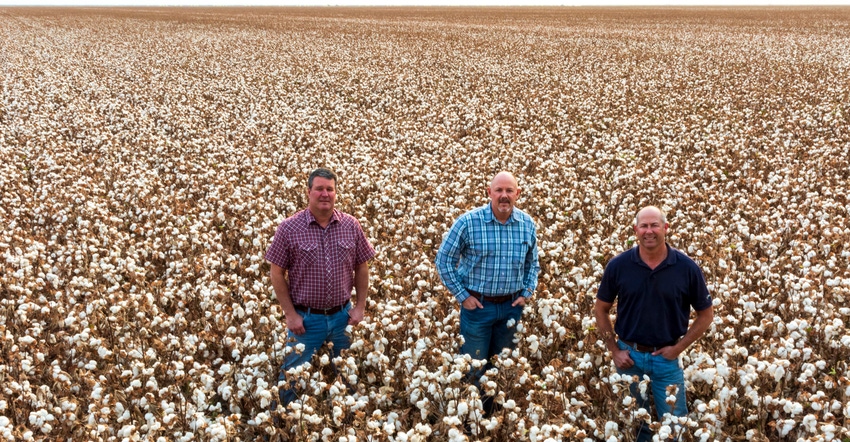
As harvest season nears, the owner of American’s premium cotton trademark is saying one-fifth of that crop is already sold. The entire U.S. Pima cotton crop may sell out by next March.
Supima continues to solidify its brand appeal in the global marketplace as it leads an effort of authenticity and traceability. The selling point with buyers of premium U.S. cotton is not about “sustainability,” a word with many definitions, but the need to prove claims that the cotton used in apparel and other products are truthful. Technology is allowing Supima to enforce its trademark and quality in ways it couldn’t before.
The current U.S. drought is aiding in supply and demand as cotton acreage shrinks in the states that can successfully produce Pima. California remains the leading Pima producer in the country, with much smaller growing regions in Arizona, New Mexico, and Texas.
U.S. Pima crop
The U.S. Department of Agriculture says total Pima production for this year could be 407,000 bales. Most of that – about 295,000 bales – will come from California. Arizona could produce 42,000 bales, while New Mexico and Texas produce 36,000 and 34,000 bales, respectively.
Last year’s Pima crop sold out early as clothing manufacturers and others demand the high-quality premium cotton produced by U.S. cotton growers. Buyers are now willing to pay a higher premium for that cotton because they trust it’s quality and production methods, according to Jason Thompson, brand development manager for Supima.
The increased demand began an upward trend in grower returns for U.S. Pima cotton in late 2020. The price quickly shot up from just over $1 per pound to $3.50 per pound. Mid-summer prices this year remained well above $3 per pound.
While Pima cotton is grown entirely in the West and Southwest U.S., it is most successfully grown in California because of the climate and agronomic practices that include drip irrigation and successful control of insects that can leave a sticky residue on cotton, making it unmarketable.
Average Pima yields in California exceed three bales per acre. Bob Hutmacher, a retired Extension cotton specialist from California, said several years ago that Pima varieties he had under study could easily yield five bales under California growing practices.
Arizona’s climate is less conducive to growing a successful Pima crop according to Randy Norton, University of Arizona Extension cotton specialist. The USDA estimates that Arizona Pima growers will average slightly over 1,000 pounds (two bales) this year, while their neighbors in New Mexico and Texas may average under 1,000 pounds per acre.
“It’s not a one-for-one issue where you lose an acre in California and gain it somewhere else,” Thompson said.
The higher value and yields could fuel a comeback of sorts in the Golden State for a crop that once dominated the western San Joaquin Valley. Pima cotton acreage in California rose from 87,000 harvested acres in 2021 to an anticipated 95,000 acres this year, as overall cotton ground in the state expanded from 112,500 acres to about 125,000, the National Agricultural Statistics Service estimates.
A state pink bollworm study puts the overall cotton acreage count in California at 131,037, of which 101,407 is Pima.
Overall average production has been as high as 1.15 million bales per year, according to the California Cotton Ginners and Growers Association, before a lack of water forced many growers to switch crops or fallow fields. Pima has long been the dominant variety in California.
U.S. cotton shines
Supima’s brand sells. Licensee numbers are up to over 500. Over 50 new licensees in the past year includes mid-tier manufacturers, “and we’re getting inquiries every day,” Thompson said.
Licensees of the Supima brand don’t just seek a high-quality cotton; they seek a production style and ethos of agricultural production that U.S. cotton producers provide, and California Pima producers excel at when compared to their foreign counterparts. Environmental stewardship ranks high with buyers. It gives them a story to tell about American cotton farmers that bodes well for the U.S. cotton industry.
Thompson says American Pima cotton is making its way from high-end clothes and linens into mid- and low-tier manufacturers. While some clothing manufacturers can sell a single apparel item with Pima cotton for well over $1,000, other brands are moving into the marketplace with more reasonably priced Supima items. Target and Walmart are also said to be eying products made with Supima cotton.
The new buzzword for U.S. Pima cotton is “authenticity,” according to Supima President and CEO Marc Lewkowitz. This more aptly describes what the industry wants and Supima is willing to provide than the broad term “sustainable,” which carries with it a variety of definitions.
“We are positioned at the right time with the ability to utilize blockchain technology for data transparency and traceability to be able to authenticate the fiber all the way back to the point of where it was grown,” Lewkowitz said.
This means that nefarious claims of high-quality cotton in clothing or other materials can now be proven false through forensic testing. This can come with significant financial penalties and industry shaming, Lewkowitz said. This not only protects the Supima trademark, but it also gives Supima the ability to negotiate prices that are more advantageous to the farmers who grow Pima cotton.
Win for clothing brands
It’s also a win for clothing brand licensees of the Supima trademark that want to better position themselves in the marketplace and tell a story about how the cotton in their items is produced. It’s why Supima has seen its number of licensees grow. Much of Supima’s financial success rests in its ability to license its name to those who sell promote high-quality apparel and linens.
For the farmer able to successfully grow high-quality Pima cotton, this means higher returns from wholesale and retail manufacturers previously unwilling to pay premium prices for the product they requested. Leaders from the top clothing brands now tell Lewkowitz they are willing to pay the higher prices asked for American Pima cotton because they trust the quality and their customers continue to willingly pay the higher prices they ask.
“They see these higher prices as a cost of doing business,” Lewkowitz said.
Proving the authenticity of Supima cotton in the supply chain is now possible through forensic testing by companies that link the cotton digitally throughout the chain. These data links can trace cotton digitally from the farm to the finished product.
“In order to have true authenticity in a digital blockchain, you actually have to tie the digital asset to the physical and be able to verify and authenticate the physical such that you’re validating the digital,” Lewkowitz said. “We’re not just talking about the production of a product and saying arbitrarily, ‘this is how the product is grown’. We can tie the physical to the initial data, because we can verify that this product contains the input materials from the origination point.”
Supima will host its brand symposium later this year in California. For the past 15 years, Supima has invited its brand partners from across the globe to view the harvest process of American Pima cotton and learn firsthand how the cotton is ginned and prepared for the marketplace. The tour includes visits to cotton farms, a cotton gin, and the USDA classing offi
About the Author(s)
You May Also Like






